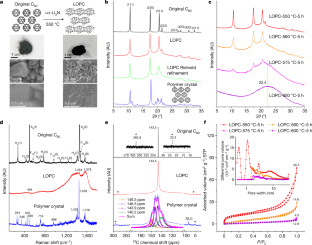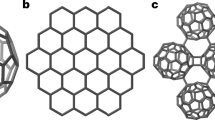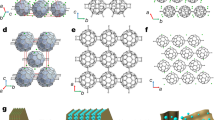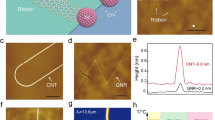Abstract
Carbon structures with covalent bonds connecting C60 molecules have been reported1,2,3, but their production methods typically result in very small amounts of sample, which restrict the detailed characterization and exploration necessary for potential applications. We report the gram-scale preparation of a new type of carbon, long-range ordered porous carbon (LOPC), from C60 powder catalysed by α-Li3N at ambient pressure. LOPC consists of connected broken C60 cages that maintain long-range periodicity, and has been characterized by X-ray diffraction, Raman spectroscopy, magic-angle spinning solid-state nuclear magnetic resonance spectroscopy, aberration-corrected transmission electron microscopy and neutron scattering. Numerical simulations based on a neural network show that LOPC is a metastable structure produced during the transformation from fullerene-type to graphene-type carbons. At a lower temperature, shorter annealing time or by using less α-Li3N, a well-known polymerized C60 crystal forms owing to the electron transfer from α-Li3N to C60. The carbon K-edge near-edge X-ray absorption fine structure shows a higher degree of delocalization of electrons in LOPC than in C60(s). The electrical conductivity is 1.17 × 10−2 S cm−1 at room temperature, and conduction at T < 30 K appears to result from a combination of metallic-like transport over short distances punctuated by carrier hopping. The preparation of LOPC enables the discovery of other crystalline carbons starting from C60(s).
This is a preview of subscription content, access via your institution
Access options
Access Nature and 54 other Nature Portfolio journals
Get Nature+, our best-value online-access subscription
$29.99 / 30 days
cancel any time
Subscribe to this journal
Receive 51 print issues and online access
$199.00 per year
only $3.90 per issue
Buy this article
- Purchase on Springer Link
- Instant access to full article PDF
Prices may be subject to local taxes which are calculated during checkout




Similar content being viewed by others
Data availability
All data supporting the findings of this work are available within the paper and its Supplementary Information. Source data can be found at https://github.com/NiKun9/fullerene_evolution. Source data are provided with this paper.
Code availability
All density functional theory calculations were performed using VASP and Gaussian 09 software, which are commercially available at https://www.vasp.at/ and https://gaussian.com/. All structural search calculations based on neutral network potential were performed using LASP software, which is commercially available at http://www.lasphub.com and free for academic usage. The Raman off-resonance activity calculator is available at https://github.com/afonari/raman-sc.
References
O’Keeffe, M. C60 zeolites? Nature 352, 674–674 (1991).
Vanderbilt, D. & Tersoff, J. Negative-curvature fullerene analog of C60. Phys. Rev. Lett. 68, 511–513 (1992).
Okada, S., Saito, S. & Oshiyama, A. New metallic crystalline carbon: three dimensionally polymerized C60 fullerite. Phys. Rev. Lett. 83, 1986–1989 (1999).
Krätschmer, W., Lamb, L. D., Fostiropoulos, K. & Huffman, D. R. Solid C60: a new form of carbon. Nature 347, 354–358 (1990).
Quo, Y., Karasawa, N. & Goddard, W. A. Prediction of fullerene packing in C60 and C70 crystals. Nature 351, 464–467 (1991).
Heiney, P. A. et al. Orientational ordering transition in solid C60. Phys. Rev. Lett. 66, 2911–2914 (1991).
Samara, G. et al. Pressure dependence of the orientational ordering in solid C60. Phys. Rev. Lett. 67, 3136–3139 (1991).
Iwasa, Y. et al. New phases of C60 synthesized at high pressure. Science 264, 1570–1572 (1994).
Nunez-Regueiro, M., Marques, L., Hodeau, J.-L., Béthoux, O. & Perroux, M. Polymerized fullerite structures. Phys. Rev. Lett. 74, 278–281 (1995).
Wang, G., Komatsu, K., Murata, Y. & Shiro, M. Synthesis and X-ray structure of dumb-bell-shaped C120. Nature 387, 583–586 (1997).
Margadonna, S. et al. Li4C60: a polymeric fulleride with a two-dimensional architecture and mixed interfullerene bonding motifs. J. Am. Chem. Soc. 126, 15032–15033 (2004).
Stephens, P. W. et al. Polymeric fullerene chains in RbC60 and KC60. Nature 370, 636–639 (1994).
Zhao, Y., Poirier, D., Pechman, R. & Weaver, J. Electron stimulated polymerization of solid C60. Appl. Phys. Lett. 64, 577–579 (1994).
Rao, A. et al. Photoinduced polymerization of solid C60 films. Science 259, 955–957 (1993).
Hou, L. et al. Synthesis of a monolayer fullerene network. Nature 606, 507–510 (2022).
Wang, L. et al. Long-range ordered carbon clusters: a crystalline material with amorphous building blocks. Science 337, 825–828 (2012).
Zhang, S. et al. Discovery of carbon-based strongest and hardest amorphous material. Natl Sci. Rev. 9, nwab140 (2022).
Shang, Y. et al. Ultrahard bulk amorphous carbon from collapsed fullerene. Nature 599, 599–604 (2021).
Tang, H. et al. Synthesis of paracrystalline diamond. Nature 599, 605–610 (2021).
Davydov, V. A. et al. Spectroscopic study of pressure-polymerized phases of C60. Phys. Rev. B 61, 11936–11945 (2000).
Okotrub, A. et al. Electronic structure and properties of rhombohedrally polymerized C60. J. Chem. Phys. 115, 5637–5641 (2001).
Burger, B., Winter, J. & Kuzmany, H. Dimer and cluster formation in C60 photoreaction. Z. Phys. B 101, 227–233 (1996).
Yannoni, C., Johnson, R., Meijer, G., Bethune, D. & Salem, J. 13C NMR study of the C60 cluster in the solid state: molecular motion and carbon chemical shift anisotropy. J. Phys. Chem. 95, 9–10 (1991).
Hiroyama, Y. & Kume, K. High resolution 13C NMR spectra in graphite chemical shift and diamagnetism. Solid State Commun. 65, 617–619 (1988).
Rachdi, F. et al. High resolution NMR studies of one and two dimensional polymerized C60. Appl. Phys. A 64, 295–299 (1997).
Gugenberger, F. et al. Glass transition in single-crystal C60 studied by high-resolution dilatometry. Phys. Rev. Lett. 69, 3774–3777 (1992).
Sundar, C. et al. Pressure-induced polymerization of fullerenes: a comparative study of C60 and C70. Phys. Rev. B 53, 8180–8183 (1996).
Juhás, P., Cherba, D., Duxbury, P., Punch, W. & Billinge, S. Ab initio determination of solid-state nanostructure. Nature 440, 655–658 (2006).
Ni, K., Pan, F. & Zhu, Y. Structural evolution of C60 molecular crystal predicted by neural network potential. Adv. Funct. Mater. 32, 2203894 (2022).
Huang, S., Shang, C., Zhang, X. & Liu, Z. Material discovery by combining stochastic surface walking global optimization with a neural network. Chem. Sci. 8, 6327–6337 (2017).
Tycko, R. et al. 13C NMR spectroscopy of KxC60: phase separation, molecular dynamics, and metallic properties. Science 253, 884–886 (1991).
Pennington, C. H. & Stenger, V. A. Nuclear magnetic resonance of C60 and fulleride superconductors. Rev. Mod. Phys. 68, 855–910 (1996).
Pan, F. et al. Phase-changing in graphite assisted by interface charge injection. Nano Lett. 21, 5648–5654 (2021).
Wågberg, T., Stenmark, P. & Sundqvist, B. Structural aspects of two-dimensional polymers: Li4C60, Na4C60 and tetragonal C60. Raman spectroscopy and X-ray diffraction. J. Phys. Chem. Solids 65, 317–320 (2004).
Wågberg, T. & Johnels, D. 7Li and 23Na MAS solid state NMR studies of Na4C60 and Li4C60. J. Phys. Chem. Solids 67, 1091–1094 (2006).
Aoyagi, S. et al. A layered ionic crystal of polar Li@C60 superatoms. Nat. Chem. 2, 678–683 (2010).
Terminello, L. et al. Unfilled orbitals of C60 and C70 from carbon K-shell X-ray absorption fine structure. Chem. Phys. Lett. 182, 491–496 (1991).
Uher, C., Hockey, R. & Ben-Jacob, E. Pressure dependence of the c-axis resistivity of graphite. Phys. Rev. B 35, 4483–4488 (1987).
Xu, J. et al. Multi-physics instrument: total scattering neutron time-of-flight diffractometer at China Spallation Neutron Source. Nucl. Instrum. Methods Phys. Res. A 1013, 165642 (2021).
Arnold, O. et al. Mantid-data analysis and visualization package for neutron scattering and μ SR experiments. Nucl. Instrum. Methods Phys. Res. A 764, 156–166 (2014).
Huang, S. D., Shang, C., Kang, P. L., Zhang, X. J. & Liu, Z. P. LASP: fast global potential energy surface exploration. WIREs Comput. Mol. Sci. 9, e1415 (2019).
Zhang, X.-J., Shang, C. & Liu, Z.-P. From atoms to fullerene: stochastic surface walking solution for automated structure prediction of complex material. J. Chem. Theory Comput. 9, 3252–3260 (2013).
Steinhardt, P. J., Nelson, D. R. & Ronchetti, M. Bond-orientational order in liquids and glasses. Phys. Rev. B 28, 784–805 (1983).
Hafner, J. Ab‐initio simulations of materials using VASP: density‐functional theory and beyond. J. Comput. Chem. 29, 2044–2078 (2008).
Perdew, J. P., Burke, K. & Ernzerhof, M. Generalized gradient approximation made simple. Phys. Rev. Lett. 77, 3865–3868 (1996).
Ernzerhof, M. & Scuseria, G. E. ssessment of the Perdew–Burke–Ernzerhof exchange-correlation functional. J. Chem. Phys. 110, 5029–5036 (1999).
Blöchl, P. E. Projector augmented-wave method. Phys. Rev. B 50, 17953–17979 (1994).
Grimme, S., Antony, J., Ehrlich, S. & Krieg, H. A consistent and accurate ab initio parametrization of density functional dispersion correction (DFT-D) for the 94 elements H-Pu. J. Chem. Phys. 132, 154104 (2010).
Sheppard, D., Xiao, P., Chemelewski, W., Johnson, D. D. & Henkelman, G. A generalized solid-state nudged elastic band method. J. Chem. Phys. 136, 074103 (2012).
Young, R. A. The Rietveld Method Vol. 5 (International Union of Crystallography, 1993).
Yates, J. R., Pickard, C. J. & Mauri, F. Calculation of NMR chemical shifts for extended systems using ultrasoft pseudopotentials. Phys. Rev. B 76, 024401 (2007).
Pickard, C. J. & Mauri, F. All-electron magnetic response with pseudopotentials: NMR chemical shifts. Phys. Rev. B 63, 245101 (2001).
Plashkevych, O., Privalov, T., Ågren, H., Carravetta, V. & Ruud, K. On the validity of the equivalent cores approximation for computing X-ray photoemission and photoabsorption spectral bands. Chem. Phys. 260, 11–28 (2000).
Li, X., Hua, W., Guo, J. & Luo, Y. Electronic structure of nitrogen-doped graphene in the ground and core-excited states from first-principles simulations. J. Phys. Chem. C 119, 16660–16666 (2015).
Ma, Y. et al. Local structures of nitrogen-doped graphdiynes determined by computational X-ray spectroscopy. Carbon 149, 672–678 (2019).
Frisch, M. et al. Gaussian 09, Revision D. 01 (Gaussian, 2009).
Acknowledgements
We thank Z. Qiao, Z. Li, Y. Luo and D. Proserpio for helpful discussion. This work is supported by National Key R&D Program of China 2020YFA0711502, Natural Science Foundation of China (grant nos. 51972299, 52003265, 52202052, 52273234, 52273239, 12004377, 11874350 and U2004214), the Key R&D Program of Jiangsu Province grant no. BE2021007-2 and Guangdong Provincial Key Laboratory grant no. 2019B121203002. R.S.R. is supported by the Institute for Basic Science (grant no. IBS-R019-D1). The Supercomputing Center of USTC is acknowledged.
Author information
Authors and Affiliations
Contributions
Y.Z., F.P. and K.N. designed the research. F.P. performed the material preparation and most regular characterizations. K.N. performed all the simulations. T.X. and L.S. performed the aberration-corrected transmission electron microscopy. H.C. and W. Yin performed the neutron diffraction and pair distribution function testing. Y.W. and K.G. performed the magic-angle-spinning solid-state 13C nuclear magnetic resonance spectroscopy and in situ testing. C.L. and D.Y. performed the electrical conductivity testing of LOPC. X.L. carried out the simulation of carbon K-edge near-edge X-ray absorption fine structure spectra. M.-L.L. and P.-H.T. performed the Raman testing. S.L. and X.W. assisted with the material preparation. W. Yan performed the carbon K-edge near-edge X-ray absorption fine structure spectra testing. Y.Z. and R.S.R. supervised the research, and provided many insightful remarks and suggestions. Y.Z., R.S.R., F.P. and K.N. co-wrote the paper. All authors discussed the results and commented on the manuscript.
Corresponding authors
Ethics declarations
Competing interests
The authors declare no competing interests.
Peer review information
Peer review information
Nature thanks Yongjun Tian, Thomas Wågberg and the other, anonymous, reviewer(s) for their contribution to the peer review of this work. Peer reviewer reports are available.
Additional information
Publisher’s note Springer Nature remains neutral with regard to jurisdictional claims in published maps and institutional affiliations.
Supplementary information
Supplementary Information
Supplementary Methods, Figs 1–31, Tables 1 and 2, captions to Supplementary Videos 1–4 and Appendix.
Rights and permissions
Springer Nature or its licensor (e.g. a society or other partner) holds exclusive rights to this article under a publishing agreement with the author(s) or other rightsholder(s); author self-archiving of the accepted manuscript version of this article is solely governed by the terms of such publishing agreement and applicable law.
About this article
Cite this article
Pan, F., Ni, K., Xu, T. et al. Long-range ordered porous carbons produced from C60. Nature 614, 95–101 (2023). https://doi.org/10.1038/s41586-022-05532-0
Received:
Accepted:
Published:
Issue Date:
DOI: https://doi.org/10.1038/s41586-022-05532-0
This article is cited by
-
Highly in-plane anisotropic optical properties of fullerene monolayers
Science China Physics, Mechanics & Astronomy (2023)
Comments
By submitting a comment you agree to abide by our Terms and Community Guidelines. If you find something abusive or that does not comply with our terms or guidelines please flag it as inappropriate.



